Pineapple casserole—a sweet and savory Southern classic—has been delighting families for generations. This dish brings together unexpected ingredients like juicy pineapple, sharp cheddar cheese, and crispy cracker topping, creating a flavor explosion that’s perfect for holidays or weeknight dinners. In this article, we’ll explore everything you need to know about this iconic dish, from its history and variations to step-by-step instructions, nutrition tips, and answers to common questions. Let’s dive into the world of pineapple casserole and discover why it’s a must-have on your table.
Introduction to Pineapple Casserole
What is Pineapple Casserole?
At its core, pineapple casserole is a baked dish that combines the sweetness of pineapple with the richness of cheese and a buttery, crispy cracker topping. It’s often served as a side dish during festive gatherings like Easter, Thanksgiving, or Christmas. While it may seem unconventional to mix fruit and cheese in a casserole, this dish strikes the perfect balance between sweet and savory flavors, making it both comforting and intriguing.
Origins and History of Pineapple Casserole
Pineapple casserole traces its roots to the American South, where combining sweet and savory ingredients is a time-honored tradition. Pineapple, once considered a rare and intriguing fruit, became widely popular in the mid-20th century, finding its way into salads, desserts, and even casseroles. Over time, this dish evolved into a beloved staple at Southern potlucks and family dinners, symbolizing the region’s flair for creative and hearty cuisine.
Why Pineapple Casserole is a Southern Staple
The enduring appeal of pineapple casserole lies in its simplicity and versatility. It’s easy to make, pairs beautifully with ham or roast chicken, and pleases even the pickiest eaters. Additionally, the combination of tangy pineapple, creamy cheese, and crunchy topping perfectly captures the Southern culinary philosophy: comfort food that surprises and delights. Whether it’s served as a side dish or a dessert, pineapple casserole continues to win hearts across generations.
Ingredients and Variations
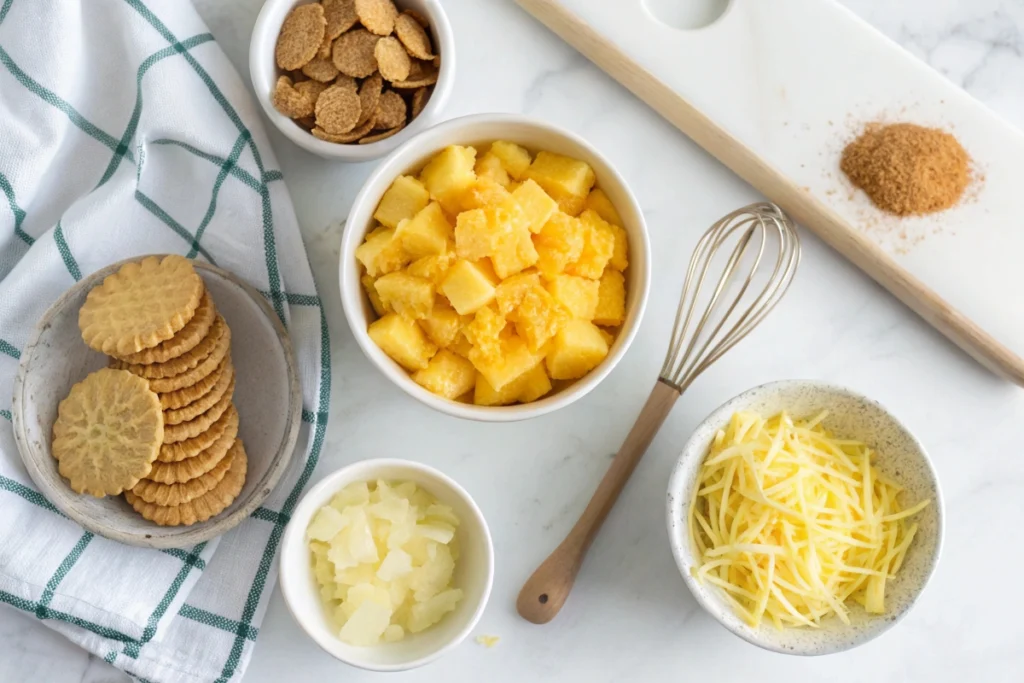
Core Ingredients in Traditional Pineapple Casserole
A classic pineapple casserole recipe requires only a handful of pantry staples. At the heart of this dish is the balance between sweet, tangy, and savory flavors. The key ingredients include:
- Pineapple: Most recipes use canned pineapple chunks or tidbits packed in juice. These offer just the right amount of sweetness and moisture for the casserole.
- Cheddar Cheese: Sharp cheddar works best to balance the sweetness of the pineapple. The tangy cheese creates a surprising but delightful contrast.
- Sugar: A little granulated sugar enhances the pineapple’s natural sweetness.
- All-Purpose Flour: This thickens the pineapple mixture, preventing it from becoming too runny.
- Butter: Melted butter binds the topping and adds richness to the dish.
- Ritz Crackers: Crushed Ritz crackers create the signature crunchy topping, giving the casserole its irresistible texture.
Sweet vs. Savory: Different Takes on the Classic Recipe
Though the traditional pineapple casserole leans sweet, some variations add savory twists. A dash of black pepper or a sprinkle of cayenne can enhance the flavor for those who prefer less sweetness. Alternatively, replacing cheddar cheese with Parmesan can add an extra depth of savory flavor. You can also experiment with mixing nuts, like pecans, into the topping for added crunch.
Exploring Cheese Choices: Cheddar and Beyond
While sharp cheddar is the go-to cheese for pineapple casserole, other options can work just as well. Monterey Jack, for instance, melts smoothly and has a milder taste. For a bolder flavor, try Gruyère or even a smoky Gouda. Each type of cheese gives the casserole a unique twist without losing its comforting charm.
Alternative Toppings: From Ritz Crackers to Breadcrumbs
While Ritz crackers are a favorite, other toppings can be used to achieve the same crispy texture. Panko breadcrumbs, crushed pretzels, or even crushed cornflakes can substitute for Ritz crackers, adding a new layer of flavor and crunch to your pineapple casserole.
Print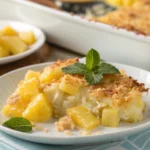
Pineapple Casserole
- Total Time: 40 min
- Yield: 1 casserole dish 1x
Description
This Pineapple Casserole is a sweet and savory Southern classic that’s perfect for potlucks, holiday gatherings, or as a side dish for a baked ham. Made with juicy pineapple chunks, buttery Ritz crackers, and a cheesy topping, this recipe balances sweet and salty flavors in every bite. It’s simple to make, full of flavor, and a guaranteed crowd-pleaser!
Ingredients
- 1 cup sugar
- 6 tablespoons all-purpose flour
- 2 (20-ounce) cans pineapple chunks, drained (reserve 1/4 cup of juice)
- 1 1/2 cups shredded sharp cheddar cheese
- 1 sleeve (about 30) Ritz crackers, crushed
- 1/2 cup unsalted butter, melted
Instructions
- Preheat your oven to 350°F (175°C). Grease a 9×13-inch baking dish.
- In a medium bowl, mix the sugar and flour. Add the drained pineapple chunks and reserved 1/4 cup of pineapple juice. Stir to coat the pineapple evenly.
- Transfer the pineapple mixture to the prepared baking dish, spreading it out evenly.
- Sprinkle the shredded cheddar cheese evenly over the pineapple mixture.
- In another bowl, mix the crushed Ritz crackers with the melted butter until well combined.
- Spread the buttery cracker mixture evenly over the cheese layer to create a topping.
- Bake in the preheated oven for 25–30 minutes, or until the top is golden brown and bubbly.
- Remove from the oven and let it cool for 5–10 minutes before serving
Notes
- For a richer flavor, use fresh pineapple instead of canned. Adjust sugar based on the sweetness of the pineapple.
- Add a pinch of cinnamon or nutmeg for a warm, spiced twist.
- This casserole pairs perfectly with ham, roasted turkey, or even barbecue dishes.
- Prep Time: 10 min
- Cook Time: 30 min
- Cuisine: Southern
Nutrition
- Serving Size: 8 servings
- Calories: 320 per serving
- Fat: 18g
- Carbohydrates: 38g
- Protein: 5g
Step-by-Step Recipe Guide
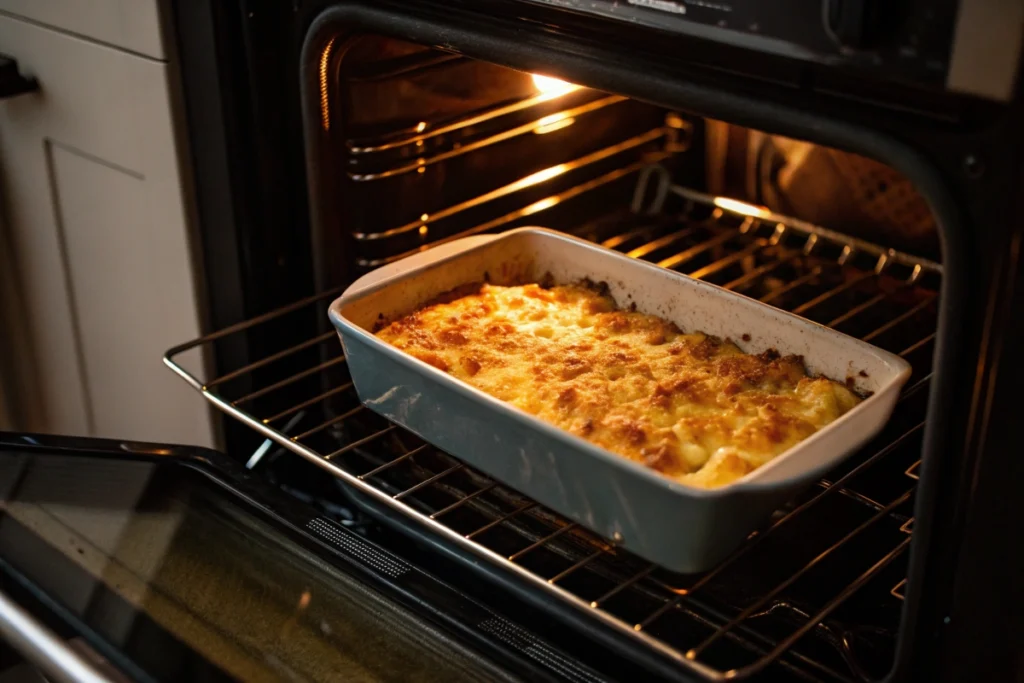
Preparing the Pineapple: Fresh vs. Canned
The first step in making pineapple casserole is deciding whether to use fresh or canned pineapple. While fresh pineapple offers a brighter, tangier flavor, canned pineapple is much more convenient and consistent in sweetness. If you choose fresh pineapple, be sure to cut it into bite-sized chunks and adjust the sugar to account for its natural tartness.
Mixing the Filling: Balancing Sweetness and Texture
To create the filling, start by combining the pineapple chunks with sugar, flour, and any spices or seasonings you prefer. Stir until the pineapple is well-coated. This mixture forms the base of your casserole and ensures the flavors meld together beautifully during baking.
Creating the Perfect Topping: Tips for a Crunchy Crust
For the topping, crush Ritz crackers into fine crumbs and mix them with melted butter. Spread this mixture evenly over the pineapple filling. The butter ensures the topping bakes to a golden-brown perfection, delivering that signature crunch with every bite.
Baking Instructions: Time and Temperature for Optimal Results
Preheat your oven to 350°F (175°C) and bake the casserole for 25 to 30 minutes, or until the topping is crisp and golden. Be careful not to overbake, as this can dry out the filling. Serve warm for the best flavor and texture.
Serving Suggestions: Pairings and Presentation
Pineapple casserole pairs wonderfully with savory dishes like glazed ham, roasted chicken, or grilled pork chops. To elevate your presentation, serve it in a decorative baking dish and garnish with a sprig of fresh mint or a light sprinkle of cinnamon.
Nutritional Information and Dietary Considerations
Caloric Breakdown and Nutrient Content
A typical serving of pineapple casserole (about 1 cup) contains approximately 423 calories. This includes 26 grams of fat, 42 grams of carbohydrates, and 7 grams of protein.The dish is also a good source of calcium, providing around 15% of the daily recommended intake. However, it’s important to note that the casserole is high in saturated fat and sugars, primarily due to the cheese, butter, and added sugar.
Adapting the Recipe for Dietary Restrictions
For those with dietary restrictions, there are several ways to modify pineapple casserole:
- Reducing Sugar: To lower the sugar content, consider using pineapple canned in its own juice instead of syrup. Additionally, you can reduce the amount of added sugar or substitute it with natural sweeteners like honey or maple syrup.
- Lowering Fat: Opt for reduced-fat cheese and use less butter in the topping. Alternatively, replace butter with a heart-healthy oil, such as olive oil, to decrease saturated fat intake.
- Gluten-Free Option: For a gluten-free version, use gluten-free crackers or breadcrumbs for the topping and ensure that all other ingredients are certified gluten-free.
- Vegan Adaptation: To make the casserole vegan, substitute dairy cheese with plant-based cheese alternatives and use vegan butter. Ensure that the sugar used is also vegan-friendly.
Healthier Substitutions Without Compromising Flavor
Enhancing the nutritional profile of pineapple casserole can be achieved with a few thoughtful substitutions:
- Whole Grain Topping: Use whole grain crackers or rolled oats mixed with a small amount of butter or oil to create a fiber-rich, crunchy topping.
- Natural Sweeteners: Replace refined sugar with natural sweeteners like agave nectar or coconut sugar to reduce the glycemic impact.
- Adding Nuts: Incorporate chopped nuts, such as pecans or walnuts, into the topping to add healthy fats, protein, and a satisfying crunch.
By making these adjustments, you can enjoy a more nutritious version of pineapple casserole without sacrificing its beloved flavor and texture.
Frequently Asked Questions about Pineapple Casserole
The best cheese to pair with pineapple is sharp cheddar. Its tangy and savory profile beautifully balances the sweet, tropical flavor of pineapple. Other great options include Parmesan for a nuttier taste, Gruyère for a creamy and slightly sweet touch, or even a mild cheese like Mozzarella if you prefer a subtler contrast. Each cheese adds a unique twist to dishes like pineapple casserole, salads, or even grilled pineapple.
Soaking pineapple in salt water helps reduce the fruit’s natural acidity and can minimize the tingling or burning sensation it causes on your tongue. Pineapples contain bromelain, an enzyme that breaks down proteins, which can irritate sensitive areas of the mouth. A quick soak in lightly salted water neutralizes some of the enzyme’s effects, making the pineapple gentler to eat without altering its flavor significantly.
Yes, canned pineapple is a convenient substitute for fresh pineapple in most recipes. It’s pre-sweetened and soft, which makes it ideal for dishes like pineapple casserole or desserts. However, fresh pineapple has a brighter, tangier flavor that adds freshness to salads and salsas. If you’re using canned pineapple, choose varieties packed in juice rather than syrup to maintain a more natural sweetness.
Cooked pineapple sets in Jell-O because the cooking process deactivates bromelain, an enzyme present in raw pineapple. Bromelain prevents gelatin from setting by breaking down its proteins. Once the pineapple is cooked, the enzyme is neutralized, allowing the gelatin to firm up properly. This is why recipes requiring gelatin, like Jell-O salads, recommend using canned or cooked pineapple instead of fresh..
Exploring the Cultural Significance of Pineapple Casserole
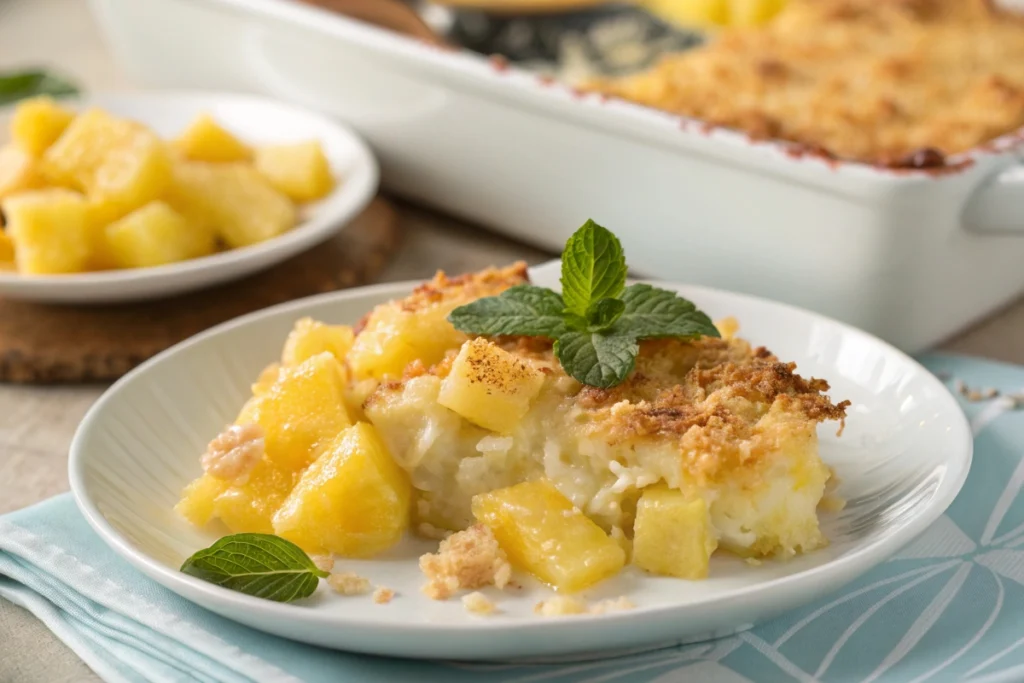
Pineapple Casserole in Southern Celebrations
In the Southern United States, food plays a vital role in bringing people together, and pineapple casserole has become a star at many gatherings. Whether it’s Easter brunch, Thanksgiving dinner, or a church potluck, this sweet-and-savory dish is often the centerpiece of the table. Its unique blend of flavors reflects the South’s love for combining comfort food with a touch of creativity.
The dish’s popularity in the South isn’t just about its taste; it’s also about tradition. Passed down through generations, pineapple casserole recipes often come with personal stories, making the dish a cherished family heirloom. For many, serving this casserole is more than just offering food—it’s a way to honor heritage and share love through cooking.
Regional Variations Across the United States
While pineapple casserole is most closely associated with the South, its appeal has spread to other parts of the country. In the Midwest, some families add marshmallows for an extra layer of sweetness, borrowing elements from traditional holiday side dishes like sweet potato casserole. On the East Coast, versions with coconut flakes or macadamia nuts can be found, giving the dish a tropical twist.
These regional adaptations highlight the casserole’s versatility and its ability to evolve while staying true to its roots. Wherever you are, pineapple casserole remains a delightful conversation starter and a crowd-pleaser, proving that great food knows no boundaries.
Reader Experiences and Recipe Tweaks
Testimonials: Why Home Cooks Love Pineapple Casserole
Home cooks across the country rave about the simplicity and flavor of pineapple casserole. Many describe it as a dish that surprises guests with its unexpected combination of ingredients. “I wasn’t sure about pineapple and cheese together,” one cook shared, “but it was an instant hit at our holiday dinner!” Others love how quickly it comes together, making it perfect for busy days when you still want something special.
Popular Modifications and Personal Touches
One of the reasons pineapple casserole endures is its flexibility. Some readers have swapped out Ritz crackers for pretzel crumbs, adding a touch of saltiness to the topping. Others have experimented with different cheeses like mozzarella or Gruyère, giving the dish a whole new flavor profile. A few creative cooks even add a pinch of cinnamon or nutmeg to the filling, enhancing the pineapple’s natural sweetness.
Encouraging Readers to Share Their Versions
Every family seems to have its own take on pineapple casserole, and that’s part of the fun. If you’ve put your own twist on this classic dish, we’d love to hear about it! Share your version and let us know what makes it special. Who knows? Your recipe might inspire someone else to try something new!
Conclusion
Pineapple casserole goes beyond just being a recipe; it celebrates creativity, flavor, and tradition. Its sweet and savory charm, combined with its deep roots in Southern cuisine, has earned it a special place in many hearts. Whether you prepare it for a holiday dinner, a casual potluck, or a cozy family meal, its unique blend of pineapple, cheese, and crunchy topping will surely impress.
With countless ways to adapt and personalize the recipe, pineapple casserole encourages you to add your twist while keeping its comforting essence intact. Gather your ingredients, embrace the joy of cooking, and create a dish that not only delights your taste buds but also sparks lively conversations at the table.
For more delicious and comforting recipes, don’t forget to explore our collection of casseroles and side dishes—your next favorite dish might be waiting for you!

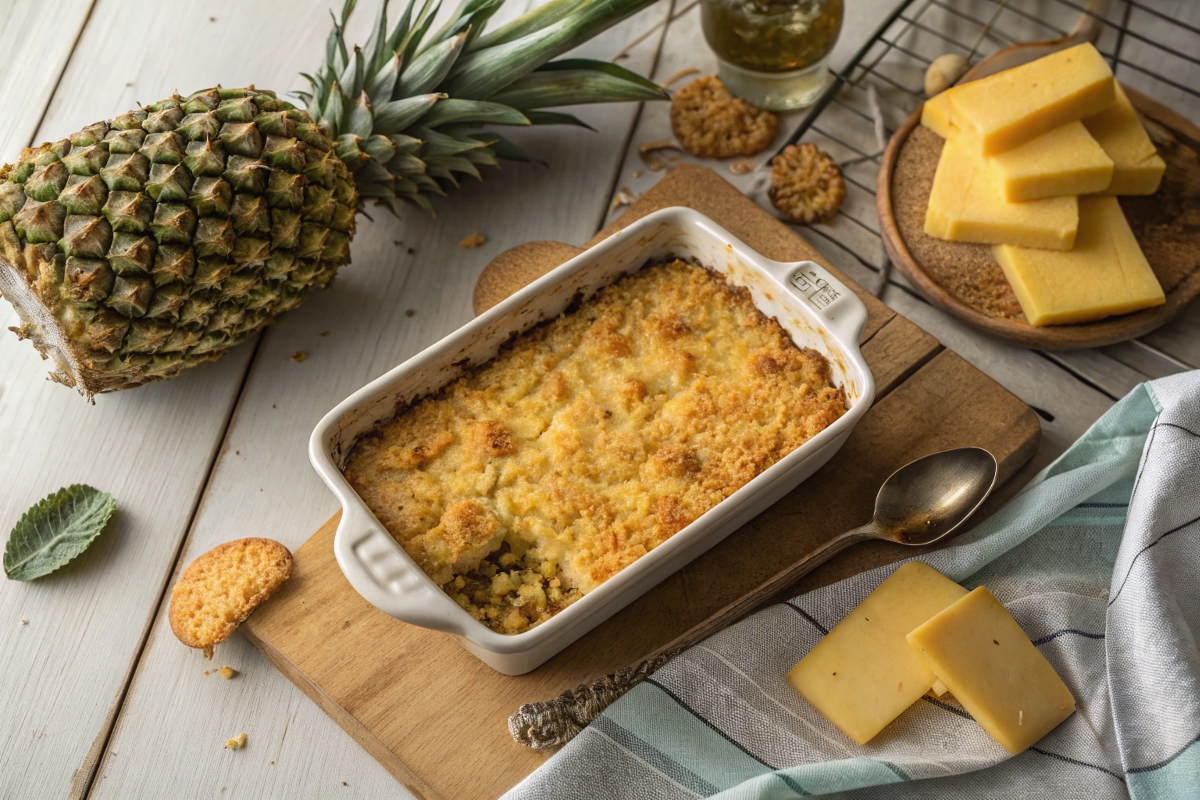
5 thoughts on “Best Pineapple Casserole Recipe: Sweet and Savory Side Dish for Any Meal”